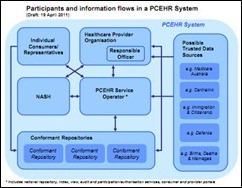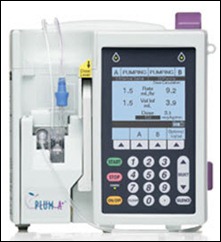HITlaw 8/29/11
Certification Obfuscation
This HITlaw installment was conceived before my July posting. I spent a tremendous amount of time over the past few months researching and discussing the issue presented here. Approached with concerns from hospitals, physicians, vendors, and consultants and having no sound, defendable answer to impart to any of them, I rolled up my sleeves and waded in.
The issue involves the unintentional consequences resulting from the certification of EHR product bundles.
Whether the certified bundle is classified as modular or complete is immaterial for the purposes of this writing. The absolute heart of the issue is recognizing that in some cases, multiple products that are marketed individually by a vendor are grouped together for testing and are ultimately certified together and not separately.
The problem is that not all customers of any given vendor have licensed all component products included in the vendor’s certified (and bundled) EHR “product”. In fact, I will go out on a limb and say that no vendor can state that 100% of its applicable customer base has licensed all components (that are otherwise individually marketed) included in the certified, yet bundled, product. If that were the case, they would have already packaged the products together in their marketing efforts. The fact that they have not supports my statement.
Unfortunately no accommodation is made for the reality that some certified EHR products are comprised of separate, individually marketed products and that provider customers have licensed only a subset of those individual products. The market mandates availability of the individual products; certification options should mimic the market.
Please do not take from this the impression that I believe vendors have done this maliciously, which I do not, or that I am maligning the Office of the National Coordinator (ONC), which I am not. I am simply the one who has chosen to raise his hand and be heard on this topic in the honest hope that others will pitch in and help.
Considerations
We know from ONC FAQ #9-10-005-1 that a single certification of a bundle of separately marketed products does not propagate certification from the bundled “product” to the subset of individual products. However, ONC also states that vendors may have the subset of products certified individually during the overall certification process. This is the very foundation needed for a very simple solution, but please be patient and read on.
We know that possession of, or a legally enforceable right to use, all components of a certified product permits a provider to add or substitute a product from a different vendor to satisfy a subset of Meaningful Use criteria, as stated in ONC FAQ #12-10-021-1, and
that ONC FAQ #9-10-014-1 permits duplicative or overlapping capabilities acquired from different vendors. However, in each case ONC requires the provider to acquire the full product as certified.
Example
Vendor X has certified an EHR solution that is actually comprised of four individually marketed products. The certification is for the “bundle” and not for four individual pieces. Hospital W previously licensed three of the four products but never licensed the fourth piece and now desires to obtain similar functionality (and achieve associated Meaningful Use criteria using that product) from Vendor Q.
However, according to ONC, Hospital W cannot acquire Vendor Q’s product (for Meaningful Use reimbursement purposes) without also acquiring Vendor X’s fourth piece, regardless of cost or dissatisfaction with the product. Or worse, if Hospital W already acquired Vendor Q’s product, it now must acquire Vendor X’s fourth piece in order to meet ONC’s requirements, even if the product will never be used. In the first scenario, the hospital has a choice, but in the second, the hospital has no option but to invest twice in similar functionality because of a vendor’s certification method and ONC’s requirements. ONC’s suggestions that the provider and vendor negotiate low cost or no cost terms for the missing piece(s) is, in my opinion, off base, as it fails to recognize the issue of the bundled products (see FAQ #12-10-021-1). If the vendor historically offered only the bundled option to its customers, then there would be no issue whatsoever.
Playing this out to the extreme, what if a provider in this situation (probably the small practice) simply makes the right choices for its operation and selects the products that best fit its needs, forgoing incentive money because it chooses not to (or is not able to) duplicate costs for multiple EHR product pieces? In the end, this provider will be penalized, not because they did not implement an EHR (which they did), but because they did not implement a “single-source” EHR that was certified in a manner inconsistent with how the applicable vendor’s products are offered in the market. This is a dramatic interpretation, I admit, but remember I am the one hearing this type of comment from members of the industry.
The Best Solution
Going forward, ONC should require vendors that choose to certify “bundled” EHR solutions to also certify any individually marketed products included in the bundle. Existing certifications of bundled products must be revisited for individual component certification. This is the simplest, most effective method for correcting the situation, and it will work.
One Alternative Solution
ONC could clarify that providers are not required to obtain all sub-products comprising a vendor’s certified product, if marketed individually by the vendor. This would enable the provider to attest to some Meaningful Use criteria using some of the sub-products that were certified as a bundle by the vendor. Being the lawyer that I am, I further suggest that this path should also have ONC clarify that attestation by providers that certain Meaningful Use criteria, but not all criteria, are met using a certain certified EHR product does not mean that they are attesting to, or representing or warranting that, they have full license or other right to use all components of that certified EHR product, or that they are meeting all possible Meaningful Use criteria associated with that product.
This would also require a redo of ONC’s Certified Health IT Product List system, because it automatically selects all criteria associated with a certified product and the user is not able to select a subset of criteria met or deselect from the complete list of criteria (this is a topic unto itself, for another day). Whew. None of this would be necessary with the first solution.
If ONC does not change its policy to require certification of components, and in fact maintains the requirement that attestation truly be “all or nothing”, meaning that in order to use portions of a certified bundled product for meeting Meaningful Use criteria a provider must acquire, from that same vendor without regard to choice or market competition, any components not previously licensed, then:
1. ONC should clarify for the nation’s providers and vendors that this is the case (which would be an egregious ruling, in my humble opinion), probably by way of a new FAQ; and
2. Vendors themselves should correct the problem by going back to the certifying entity and retesting their component products (which together were originally certified as a bundled offering) for individual certification as currently marketed. This testing can be done relatively quickly and at far less cost than the initial certification, and quite frankly, it is the right thing to do. Some vendors have heard from their customers, listened, and are already doing this.
To sum it all up as simply as possible:
Part One
Hospital executives and eligible professionals are alarmed by the fact that if their vendor certifies individually marketed products as a bundled, certified EHR solution, and if they have not licensed all of those individual products, then the only solution permitted by ONC is for the provider to acquire the balance of the products from that EHR vendor alone, eliminating all others from consideration, in sharp contrast to market reality. Yes they are free to acquire “replacement” products once they have the entire certified EHR, but the initial requirement does not sit well and does not make sense when there is a simpler solution.
Part Two
Providers and smaller vendors are hurt by the bundling of EHR products for certification purposes, because ONC requires providers to obtain all products comprising a vendor’s certified (and bundled) product, as stated in Part One.
It is not unreasonable to suggest that fair and free competition will be dramatically effected unless this situation is resolved, in which case the incumbent vendors will be unjustly rewarded because providers do not want to lose reimbursement.
The solution is simple. Vendors should be required to certify products at the same component level as marketed to the general public. This would solve the problem entirely. They may certainly certify as a bundle, but should also then certify at the component level.
Careful caveat here: if two or more otherwise individually marketed components must be certified together to meet any Meaningful Use criteria (and neither would meet the criteria on its own) then obviously they cannot be certified separately.
Part Three
Recognition by appropriate authorities of the absolute need to clarify and correct this situation in a timely and effective manner is essential for the nation’s healthcare providers and HIT vendors.
In Closing
The very fact that vendors can correct this oversight in the certification process is perhaps the most incredible part of the story. Hopefully there is enough substance here to make intelligent minds in all related aspects of the ARRA/HITECH/HIT world take notice and then action. For the people at ONC and the certification/testing entities, let us please make the solution a reward and not a penalty. In this case, “go with the flow” is sound advice. The HIT industry has started the correction on its own. Please step in and make it all work.
Open invite: please contact me if you would like to participate and lend your insight, either in support of my views or in contradiction. Whether vendor, consultant, hospital executive, physician, legislator… come one come all.
Here is the question that I submitted to ONC.Certification@hhs.gov:
Why does ONC permit EHR vendors to certify bundles of individually marketed products as a single EHR solution without also requiring the vendors to certify the individually marketed products? Not every customer of a vendor licenses all the individual products in a bundled EHR “product.”
Perhaps if ONC receives a few more questions like this it might merit FAQ status.
William O’Toole is the founder of O’Toole Law Group of Duxbury, MA.
























































































































Merry Christmas and a Happy New Year to the HIStalk crowd. I wish you the joys of the season!